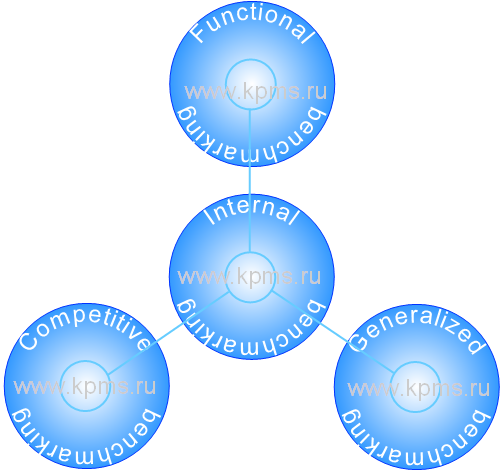Benchmarking is a comparison of products, services or processes of one organization with products, services or processes of another organization. Sometimes, comparisons are made within the same organization. The purpose of benchmarking is to find improvements. Benchmarking is used by an organization that wants to improve its activities.
Benchmarking
It is selected a company that occupies a leading position in a particular issue for comparison. It is not necessary to choose direct competitors in order to conduct benchmarking. It can be selected a company from another field of activity, or working with a different group of consumers for comparison.
Benchmarking allows you to apply the best practices of other companies in your work. But, you need to achieve a complete understanding of your own processes first, because it is impossible to make an adequate comparison without having an idea about own activities. You need to know the consideration processes boundaries, the operations performed, the current level of execution of processes and other parameters that characterize the work.
Benchmarking types
Benchmarking can be divided into several types depending on the comparison objects:

- Internal benchmarking - this benchmarking type is compared processes (products, services) within the organization. Similar processes (products, services) are selected as benchmarking objects. It is quite easy to collect data with internal benchmarking, but the possibilities for comparison are limited and the results may be biased.
- Competitive benchmarking - the comparison is carried out with direct competitors (for products or services) operating in the local, regional or international market. It is necessary to choose competitors at a different market "level". For example, an organization operating in the local market may choose an organization operating in the international market for comparison. The obtained data for comparison will be more reasonable and important in this case, but they are quite difficult to obtain.
- Functional benchmarking Ц it is compared the own organization processes with similar processes of another organization. Another organization must working in a different scope. You can get objective and important data with less effort, using ethical and legal methods of obtaining information.
- Generalized benchmarking Ц it is selected the organizations that have the best processes and approaches in their segment for these benchmarking type. Such organizations publish information about their activities openly. There are some examples of publications - the Toyota production system, or the Motorola 6-sigma system. The most suitable processes and approaches are selected for study and comparison. They adapt to the conditions of their own organization, after that.
Different resources are used as sources of information for choosing an organization for benchmarking. There are publications on commercial activities, databases of consulting and auditing companies, lists of winners of quality awards, etc.
Benchmarking Stages
One or more benchmarking types are used to improve the activity. The benchmarking objects and the research direction may be different in this case. However, the main stages will be the same for all benchmarking types. This actions order was developed as a result of the benchmarking implementation practice by many organizations.
The main stages of benchmarking include:
1. Definition, analysis and detailing of the benchmarking object. It can be selected the processes, services, or products of an organization as a benchmarking object. It is important to understand how much the organization resources and efforts can to spend on the benchmarking process. Will benchmarking a single event or become a permanent practice of the organization?
2. Identification and determination of the benchmarking object characteristics. It can be important customer properties of a product or service or process quality parameters.
3. Forming a benchmarking team. It should include specialists from various departments of the organization in the team. This allows you to evaluate the capabilities of your own processes (products, services) and the processes (products, services) of your benchmarking partners more extensively and objectively.
4. Benchmarking partner selection. The organizations can act as benchmarking partners if they have succeeded in implementing the interest characteristics of the benchmarking object (see step 2). It can be one or several organizations as a partner(s). If internal benchmarking is performed, then related departments, processes or products by the organization itself will be provided as a partner.
5. Information collection and analysis. It may be necessary to introduce the information in the same form as it is presented inside the organization, in order to make a comparison. For example, the product technical characteristics may differ from one manufacturer to another. If you need to compare these characteristics, then you will need to give them to the same УbaseФ.
6. Assessment. It is need in order to evaluate the organization`s possibility in achieving the necessary characteristics in comparison with a benchmarking partner (or partners). The assessment can be carried out by various methods (for example, GAP analysis). It is necessary to assess the existing "gap" between your own organization work and the work of a benchmarking partner.
7. Possible changes identification. The organization should determine the necessary changes in existing work practices. A "vision" of the organization future state is being developed at this stage. This vision should be based on the results of adapting the processes of the benchmarking partner to the conditions of own organization.
8. Strategic goals and plans development. The organization should develop strategic goals and plans for achieve these goals in order to get the desired level of characteristics. Plans may affect changes (depending on the scale of changes) in processes, in management systems, in organizational systems, in work culture, etc. aspects.
9. Implementation of changes. The changes should be implemented in the organization work at this stage. It is necessary to control the progress of transformations in the organization. The plans can be correction if necessary.
10. Repeat benchmarking circle. If the goals are achieved and all plans are implemented, then the organization may decide to repeat the benchmarking cycle, but for new conditions.
The organization must decide how many resources it can allocate for benchmarking before applying it as a tool for improving activities. It is better to conduct benchmarking using well-developed methods. The benchmarking technique can significantly save work time and resources. Benchmarking can use as one of the tools for continuous improvement. It can be separated into an independent process at this case.
Benchmarking advantages
Benchmarking can give the company many advantages, if it is carried out correctly. The criteria for successful benchmarking are a well-chosen team, deep detailing of processes, management's interest in the results, and integration of benchmarking results with strategic development plans.
The benchmarking team has the opportunity to look at own organization from the УoutsideФ. This allows team to go beyond daily activities and existing limitations, and find new ideas to improve work. It can be avoided many mistakes and can be increased the organization profit due to the use of benchmarking.
